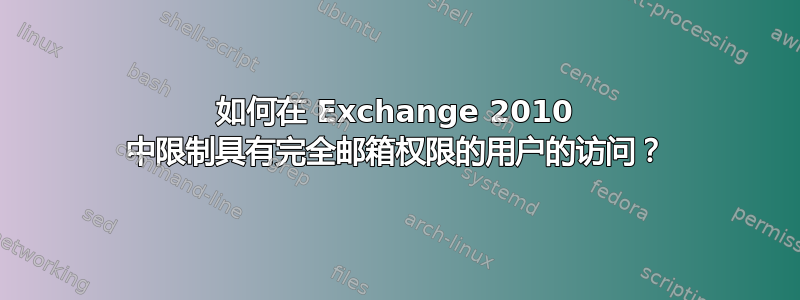
我遇到一个问题,用户 [1..10] 对用户 A 的邮箱拥有完全邮箱访问权限。
用户 A 现在想要限制访问权限,以便所有用户 [1..10] 都可以访问除“已发送邮件”和“已删除邮件”之外的内容。在此情况下,用户 2 和用户 3 应继续拥有先前请求的访问权限。
有没有一种简单的方法来限制对文件夹的访问,而不必删除“完全邮箱权限”权限并将每个人的用户权限应用于每个特定文件夹?
如果这个问题之前已经有人问过并回答过,抱歉。我确实看过了,但我认为谷歌无法理解我的问题。
我通过 powershell 执行此操作,因为这需要在多个邮箱中重复多次。
答案1
不。
完全访问权限胜过一切,因为 Exchange 具有最高权限,因此完整邮箱的权限高于文件夹级别的权限。
因此,唯一的选择是删除完全邮箱访问权限并在文件夹级别授予权限。
您应该能够使用 PowerShell 授予邮箱中所有文件夹的权限,然后删除所需文件夹的权限。但是,这也意味着新的顶级文件夹需要更改其权限(新的子文件夹继承)。
答案2
谢谢@Sembee。
对于那些必须这样做的人。这里有一个快速而粗糙的脚本来执行此操作。请在实时邮箱上使用之前对其进行测试,并根据需要进行调整。
# The mailbox to apply the permissions changes on
$mailbox = "[email protected]"
# The users to add to the mailbox folder list
$users = "[email protected]"
# Get a list of folders in the mailbox defined above. We want only the folder path
$folderlist = Get-MailboxFolderStatistics -Identity $mailbox | select FolderPath
# Create a List item consisting of string objects
[Collections.Generic.List[String]]$sList = New-Object -TypeName Collections.Generic.List[String]
# Loop through the entire list of folders and do something
foreach ($folder in $folderlist)
{
# Get the folderpath object from the folderlist and output it as a string value
$sfoldername = $folder.FolderPath | Out-String
# Look for the tree node called "Top of Information Store" and replace it with a /
$sfname = $sfoldername -replace "/Top of Information Store","/"
# replace all back slashes with forward slashes
$sfname = $sfname -replace "/","\"
# remove any hidden characters that might be lurking around in the string
$sfname = $sfname.Trim()
#Perform a bunch of IF statements in a simple way.
switch($sfname)
{
# System Folder in Mailbox. Do nothing if these are encountered
"\Recoverable Items" {break;}
"\Deletions" {break;}
"\Purges" {break}
"\Versions"{break;}
"\Quick Step Settings"{break}
"\Conversation Action Settings"{break;}
"\News Feed"{break;}
# Add the folder name into the list of strings defined earlier
default{$sList.Add($sfname);break}
}
}
# For each item in the list of strings apply permissions
foreach ($item in $sList)
{
# concatenate the foldername to contain the mailbox name and the folder path in a format the Set and Add permission command can understand.
$foldername = $mailbox + ":" + $item | Out-String
# remove any hidden characters that might be lurking around in the string
$fname = $foldername.Trim()
# Add the permissions on the folder assuming permissions haven't already been set
Add-MailboxFolderPermission -Identity $fname -AccessRights Owner -User $users
# If the user permissions already exists then set / update the permissions
Set-MailboxFolderPermission -Identity $fname -AccessRights Owner -User $users
}
确保你对此非常小心。需要注意的一点是,如果你想使用组来控制访问,请确保将该组设置为 Active Directory 中的安全组,然后将其用作分发组。否则,使用组进行访问控制将不起作用。


